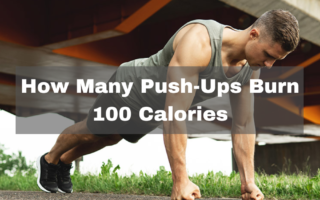Calisthenics is one of the best exercises that you can do. Actually, you NEED to train calisthenics even if you still practice traditional barbell training or use machines. In fact, three of the best exercises for your upper body actually fall under this type of training:
- Chin-Ups or Pull-Ups
- Dips
- Push-Ups
If you aren’t doing these, you need to start.
Regardless, some people are interested in running a purely calisthenic program as it offers many benefits. However, this style of training has two common problems with it.
1) The first problem is not knowing how to start. Many calisthenic exercises require an initial level of strength to even perform one rep.
2) The second problem is not knowing how to progress. Being that you only have your body, it’s a bit difficult to know how you can make exercises harder.
This article is going to show exactly what you need to do to benefit from this awesome style of training.
What Is Calisthenics?
First, let’s be clear about what we mean when talking about “calisthenics”. Calisthenics is a style of training that is focused on training a person to master control over their own body weight. To do this, a calisthenic program will use minimal equipment while focusing solely on using the body for resistance. Some common pieces of equipment that are used for a calisthenic program are:
- Pull Up Bar
- Parallel Bar
- Parallettes
- RIngs
- Bench or Stairs or Ledge
Some advanced trainees may opt to use some form of weight to increase the load. However, this is done just to add weight to the body; the trainee does not actually move the weight. In reality, the sport of gymnastics is primarily made up of calisthenic movements.
The Many Benefits Of Calisthenics
Calisthenics has a ton of great benefits that make it an attractive training style when comparing it to other methods.
It’s Cheap!
Being that you basically only use your body weight, calisthenics is an extremely cheap option for training. While you would need access to some sort of a park with bars, you shouldn’t have to spend much money on anything. Compare that to other styles where you need to pay for gym memberships, specialty shoes, lifting belts, straps, etc. If you don’t want to spend cash to get fit then calisthenics is definitely for you!
You Can Do It Almost Anywhere
While having access to a park with bars is a huge plus, you can get in a great workout almost anywhere if you need to. This makes it ideal for those who travel a lot or for those who live in more remote areas away from gyms. Even if you don’t have access to pull-up bars, you can use trees or other natural objects. This is [art of calisthenics that makes it so much fun!
Calisthenic Exercises Are Extremely Effective
The most important benefit of calisthenic training is it’s extremely effective; If you need proof, just look at gymnasts! Calisthenics works so well because, for one, you always use compound movements which as superior for building overall mass and strength. Since these movements use a lot of muscle, they also burn a ton of calories.
Calisthenics is also the definition of functional fitness as all of the movements that are performed are done in the way your body naturally moves. Pushing your body up, pulling your body up, squatting….all performed in a way your body was naturally designed to move.
Some Of The Drawbacks To Calisthenics
No style of training is perfect for everybody and this includes calisthenics. You want to know what these drawbacks are when beginning a new style of training so that you know what to expect.
Difficult to progress on
As mentioned above, calisthenics tends to be much more difficult to progress on especially when you are first starting out. It can also be more difficult to see. When you are at the gym you are able to simply add weight to the bar to see if you improving. Calisthenics doesn’t have this option and it can take a lot of time to be able to add a rep. Or, some advanced moves can take months and months to be able to do. There is a much larger learning curve but if you are patient, it will pay off.
Not Suitable For Those Wanting Huge Mass
To be clear, you can absolutely add muscle mass using calisthenics. However, there does seem to be a threshold with calisthenics; especially for the lower body. Again, this is due to the limited amount of movements you can do when compared to having access to an entire gym. If you are wanting to be a bodybuilder, calisthenics as your sole style of training won’t cut it. If you want to be athletic with decent size and great aesthetics, calisthenics is just what you need.
5-Day Beginner Calisthenics Workout
So here is the workout you are going to do. First, we will just establish the basic layout and then go into how you can alter it for your needs and progress.
When performing a calisthenics program, remember this; calisthenics is the same as using weights in the effect it has on your physiology. Therefore, the same basic rules apply. Some people (and trainers) suggest that you can do calisthenics every day. This isn’t really true assuming that you are working with the appropriate intensity. Yes, you can do a few chin-ups and push-ups every day. No, you can not do a full-body workout every day using progressive overload. Or, you’ll often see calisthenic exercises performed as circuits. There’s nothing wrong with circuits training for conditioning and under the right circumstances. HIIT with calisthenics has been found to be very effective in maintaining fitness levels for athletes who have lost access to a gym for an indeterminate amount of time. However, if you want to get stronger you need rest in between your sets just like in the gym.
With that being said, you will hit every muscle group twice a week as this is the optimal frequency to maximize optimal volume while allowing adequate rest. You will then train skilled movements in one day. Together, you will be training the upper body 2 days a week, the lower body 2 days a week, and use one day to work on higher-skilled movements such as handstands, planks, flags, etc. This will look like the following:
Day 1- Upper Body
Day 2- Lower Body
Day 3- Rest
Day 4- Upper Body
Day 5- Lower Body
Day 6- Skills
Day 7 – Rest
Now The Program
When we program calisthenic exercises, many movements won’t use a standard rep scheme such as 3 X 5. This is mainly due because everyone is at a different starting point concerning their relative strength. For example, take two guys who can both perform 10 reps of 100kg on the bench press. However, one guy weighs 80kg while the other guy weighs 120kg. Even though they can bench press the same amount, their push-up ability will be different. Therefore, you will use the rate of perceived exertion (RPE) to monitor your training with most exercises. Using a scale of 1-10, RPE training basically has you train up to the perceived level of difficulty. This method has been found to be just as, if not a better means of training while also helps monitor fatigue.
For example, if you are supposed to do pushups until an RPE of 8 if you can do 10 pushups you; want to stop at 8. Obviously, some of you won’t have a huge rep range to choose from, especially with chin-ups. If you can only do 3 chin-ups right now and you are supposed to do 5 sets to an RPE of 8, you’ll stop at 2.
Concerning rest, you’ll want to rest at 1:00-2:00 for all of these depending on your time frame.
Day 1
- Pushups 5 @ 8 RPE
- Chinups 5 @ 8 RPE
- Dips 5 @ 8 RPE
- Australian Rows 3 @ 9 RPE
- Pike Pushups 3 @ 9 RPE
- Toe-to-bar OR knee-to-chest 3 @ 8 RPE
Day 2
- Squats 5 @ 8 RPE
- Lunges 5 @ 8 RPE
- Box Jumps or Knee Tucks 3 x 15
- Single-Leg Romanian Deadlift 3 X 8 RPE
- Side Lunges 3 X 20 ft (both ways)
- V-Sit Ups 3 @ 8 RPE
Day 3
Rest
Day 4
- Decline Pushups 4 @ 8 RPE 1 X Failure
- Pull-Ups 4 @ 8 RPE 1 X Failure
- Dips 4 @ 8 RPE 1 X Failure
- Close Grip Underhand Grip Australian Rows 4 @ 8 RPE 1 X Failure
- Incline Pushups 4 X @ RPE 1 X Failure
- Plank OR Single Arm Plank 3 @ 9 RPE
Day 5
- 4/3/1 Tempo Squats 4 @ 8 RPE
- 4/3/1 Temp Plie Squat 4 @ 8 RPE
- Bulgarian Split Squat 3 @ 8 RPE
- Single-Leg Hip Thrust 3 @ 8 RPE
- Cycle Lunges 3 X 20
- Sprint Intervals :30/:30 X 5
- Flutter Kicks 3 X 50
Day 6
Rest
Day 7
- Work on Handstand
- Work on Cobra Pose
- Work on Dragon Flag
How To Progress With A Calisthenics Program
Now that you have a basic layout, we can talk about how to progress after the first week. In reality, it’s very simple. You just apply progressive overload just like you would in the gym. While you will be using RPE as a guide, you still need to track your numbers so that you can make an effort to add some reps the following week. Now, you most likely will not be able to add a substantial amount of reps every week but all you need is one.
Let’s take chin-ups for example. Let’s say your first 5 sets of the first week looked like this:
3,4,4,3,3. The next week you’d want to add in one rep such as 3,4,4,4,3. It’s that simple so don’t make it more complicated than it needs to be.
Eventually, you will become strong enough that regular pushups and chin-ups are just too easy to create a significant enough load to cause muscle growth. This will likely come soon with your lower body exercises. In this case, you will need to progress in the difficulty of your movements. Below will show the basic progression plan for your main movements.
Calisthenics Progression For Push-Ups
Pushups are an amazing exercise but they will become too easy fairly soon for many trainees. Below are a series of movements to create a greater stimulus.
1. Side-To-Side Pushups- For these, your setup will be the same. However, when you come down you will bring your body down to one hand and then back up. Then go down to the other side.
2. One-Side Elevated- On these, you will need some sort of object like a stair or stack of books. You will place one hand on the object and one hand on the ground as normal. The higher the object, the more difficult the movement.
3. One Arm Extended- Have one hand in the normal position and then have your other hand extended all the way out to the side. You will then come down to your hand and come up. For these, you train one side at a time
4. One Arm Push Ups- Place one arm on the ground and the other either behind your back or on your back leg. Now, go down and come up. These are easier done at first with a wide stance and going down to your hand.
Calisthenics Progression For Chin Ups and Australian Rows
Both of these movements use similar progression patterns so you will just need to alter slightly for what one you are doing.
1. Finger Chin Ups: For these, you will perform the movement in an identical fashion but you will use your fingers for one hand to grab the bar. Eventually, you will want to work down so that you are using one full hand while only using one finger for the other hand.
2. Close Grip (Overhand and Underhand): Not so much a progression but a great variation. Simply do the movement but have your hands close together
3. One Arm Out: Grab the bar with one hand in the normal position while extending your other arm out and grabbing the bar
4. False One-Arm Chin-Up: Grab the bar normally with one hand and then use your other hand to grab the wrist of the one holding the bar
5. One-Arm Chin-Up: These are very hard and few can do them. But, grab the bar with one hand and pull yourself up
Calisthenics Progress For Dips
Dips are hard to progress on as there is not a lot to do. However, there is one great variation.
1) Front Bar Dip- Instead of using a set of parallel bars, use a single bar in front of you. This is a pre-requisite before doing a muscle up
Calisthenics Progress For Your Lower Body
Your main goal for your lower body is to do single-legged squats. For all of these (except Nordic curls), your best way to do them is to start by using some sort of support to help you such as TRX straps or just holding onto a pole.
1) Pistol Squats- Pistol squats are single-legged squats whereas you go down, one leg is extended out in front of your body
2) Skater Squats- As you go down on one leg, your other legs go out behind you. These almost look like a lunge where your knee never touches.
3) Single Legged Squats- You will need some form of a high ledge. Stand on the side of the ledge and perform a squat with one leg off the ledge.
4) Nordic Curls- This is the only movement that isn’t a squat. You will need to get on your knees and secure your ankles, preferably with the help of a friend. Slowly lower your body while trying to keep your torso straight. ONLY TRAIN THE ECCENTRIC!
Bonus: Training For Muscle Ups
As mentioned above, you will need to train front bar dips. Other than that, the best exercise is to train sternum pull-ups and power pull-ups. The goal of these is to explosively pull your body as high as you can above the bar. After practice, you’ll be able to get high enough so that you can transfer into the dip position and push your body up. There is really no secret except that you will “feel” it. The only advice is to lean your body over the bar when you first start.
The Ultimate Calisthenics Workout
And that’s it. You can keep the same layout and then gradually work on your progressions. Again, the biggest thing to remember is to treat calisthenics training the same way as you would with barbell training. The only difference is your selection of exercises.
Calisthenics will definitely get you in the best shape of your life…you just need to put in the time and effort!
Frequently Asked Questions
Can You Train Calisthenics Every Day?
As mentioned above, not if you are working at the appropriate intensity. Treat your rest and recovery the same as traditional resistance training.
Can You Build Muscle With Calisthenics?
Yes! Any style of training that implements progressive overload is capable of building muscle!







